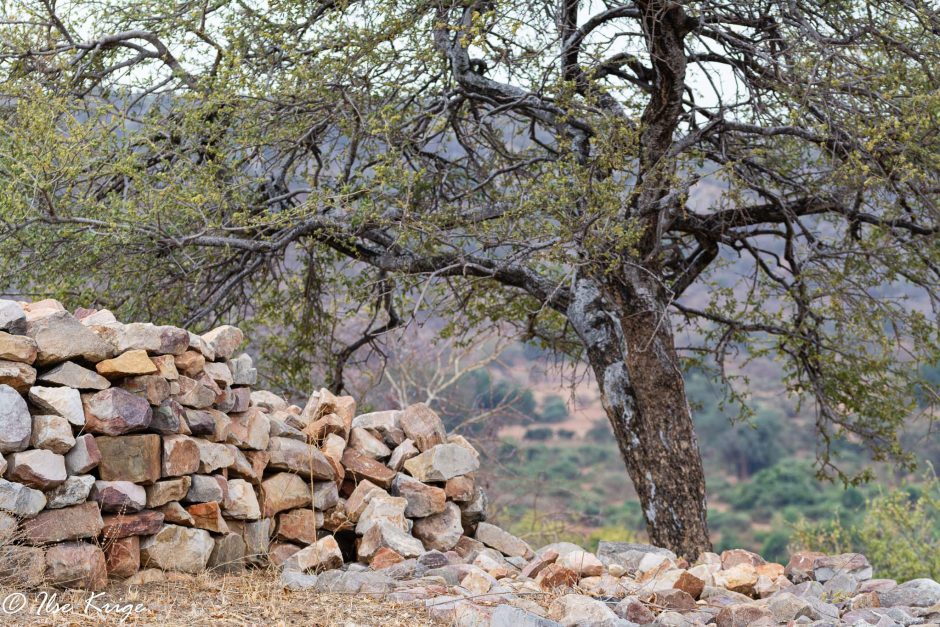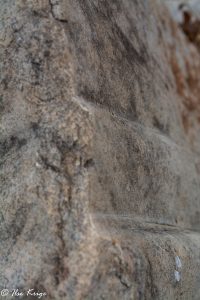19 August 2019
That damn bucket list! It just gets longer and longer no matter how many fabulous experiences we mark as done.
A major tick was our August 2019 visit to the Thulamela Archaeological Site in the northern Kruger National Park. A previous attempt ended in a dead end at a closed road on the day before we were due to head south to another camp, which required an early start.
Careful research revealed that we needed a guide and that the tour only takes place if there are four or more participants. With this information safely stored in the back of our minds we were delighted to make friends with two people with the same item on their bucket list and some free time available to share a trip to the park.
We met up at Punda Maria Rest Camp on a cool Monday afternoon, ready for an adventure. The Two Twits made their way straight from home via the Phalaborwa Gate and the H14 and H1-6, a good 206km trip and 6 hours one way. Our trip was enlivened by a mating pair of lion, under a mopani tree, close to the side of the road. He was keen, she was a little bitchy and the tourists gave them no privacy. Luckily they did not charge us - that would have amounted to pornography!
Sumi and Sarah opted for the brave way, via Nelspruit, taking whatever campsite presented itself in an extremely fully booked park. Some serious driving, especially the 375km between Berg-en-Dal to Shingwedzi, an 11-hour drive!
Punda Maria, the most northern rest camp of the Kruger, is a true gem, hugging the slopes of the Dimbo koppie with its dense covering of Lebombo ironwood trees and offering the spectacular Mahonie Loop (S99) that skirts the camp and the koppie and never disappoints with regards to animal and bird sightings. This destination makes the drive north through the sometimes monotonous mopani thickets absolutely worthwhile.
The camp also sports a very productive flood-lit water hole and the end-of-winter-season brought large herds of buffalo and elephant and lots of other critters. Luckily there is enough clear space along the fence to park your camp chair when the hide bursts its seams with intent animal spotters at all times of the day (well, we did not check the situation between 22h00 and 5h30 – we were too busy checking the insides of our eyelids).
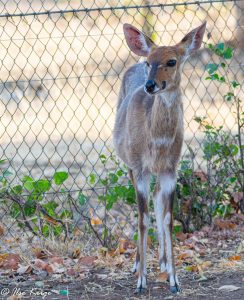 Bushbuck Ewe (Tragelaphus scriptus)
Bushbuck Ewe (Tragelaphus scriptus)
 Nyala Ewe (Tragelaphus angasii) and Zebra (Equus quagga) - Punda Maria Waterhole
Nyala Ewe (Tragelaphus angasii) and Zebra (Equus quagga) - Punda Maria Waterhole
 Crested Guineafowl (Guttera edouardi)
Crested Guineafowl (Guttera edouardi)
Animal visitors inside the camp consisted of vervet monkeys, bushbuck, vervet monkeys, crested guineafowl, vervet monkeys, hornbills of all varieties, etc. Did I mention the vervet monkeys, especially the one with our bag of muesli clutched to its chest? Visitors are warned that food is not safe unless securely closed away. The situation is serious enough for camp management to deploy a platoon of monkey-chasers during the daylight hours, which we were thankful for, our breakfast was saved through their timely intervention!
After an enjoyable afternoon drive on the Mahonie Loop, we set up camp. The Twits erecting their room with a view on the top of the Hilux and Sarah throwing a small lime green parcel on the ground. Lo and behold, up sprung a tent! We were amazed! As was Sarah.
Braai fare, chatting and laughter was the order of the day for supper and soon we were tucked in for the night. An early start was required the next morning to meet our Thulamela guide at the Pafuri Picnic Site at 8h00.
The Pafuri Picnic Site, 48 km by road north of Punda Maria, is set on the banks of the Luvuvhu River under a stand of large mature shady trees, amongst which sausage trees with their large fibrous fruit (pasoppiekoppie) and jackalberries with their shiny evergreen leaves. It is a bird watcher’s paradise and a knowledgeable site attendant is on duty. The site has flush toilet facilities and gas skottel-braais are available for hire. It is up to you to provide the cook, eggs, bacon, condiments and whatnot for a breakfast experience of note.
We met our guides, Fionah and Carel, and were loaded on a game drive vehicle for the trip to the archaeological site about 10km south-west of the picnic spot. There is a walk of about 1km up the hill from the parking area. It being a dangerous game area, Fionah and Carel were armed with rifles, and we felt very safe.
 Carel the Guide, in Full Flow
Carel the Guide, in Full Flow
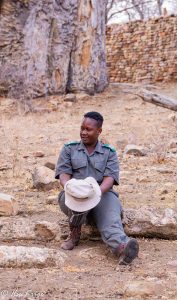 Fionah, in a Supporting Role
Fionah, in a Supporting Role
 Sumi and Sarah, fascinated
Sumi and Sarah, fascinated
Thulamela (a VhaVenda expression meaning “Place of Birth”) is a stone walled site that dates back to 1250 AD. It is a late Iron Age site and is an offshoot of the Zimbabwe culture which is believed to have started at Mapungubwe in South Africa (see our blog posting about our visit to Mapungubwe in February 2019). When the Mapungubwe monarchy declined, Great Zimbabwe grew in power and absorbed many of the scatterlings of Mapungubwe. As we all know: “what goes up, must come down”, so Great Zimbabwe itself was abandoned 300 years later, possibly due to political strife (nothing new under the sun). Several groups moved south across the Limpopo river into the north eastern areas of South Africa and established new smaller chiefdoms such as Thulamela.
Monolith - For Protection
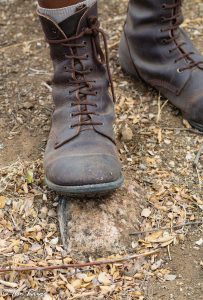 Original Foundation, as Pointed out by Carel's Boot
Original Foundation, as Pointed out by Carel's Boot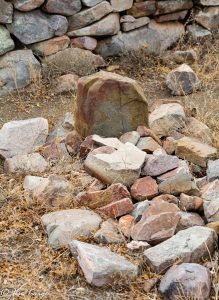 Grave of a High Ranking Lady
Grave of a High Ranking Lady
Artefacts Found on the Site
The websites www.sanparks.org/parks/kruger/people/heritage/thulamela.php and www.krugerpark.co.za/thulamela-kruger-national-park.html tell us that according to oral histories, the Nyai division of the Shona–speaking Lembethu occupied Thulamela and believed that there was a mystical relationship between their leader and the land. They believed that the ancestors of the leader (or Khosi) would intercede on behalf of the nation. The Khosi, who was an elusive figure and could only be seen by certain individuals, lived in a secluded hilltop palace in view of the commoners as an indication of his sacredness. This set-up can be seen at both Thulamela and Mapungubwe where the chieftain or king had his residence on an elevated koppie with stunning views while his underlings lived in the lower-lying areas.
With the chief lived his wives and attendants and his most important aides. In the case of Thulamela there was the Messenger (a close and trusted confident who kept the chief informed of all court proceedings and visitors), the Personal Diviner and Herbalist (who safeguarded the Chief’s health and scrutinized the intention of the visitors), the Makhadzi or ritual sister (a female co-ruler who served as national advisor and was privy to council decisions. She played a large role in the appointment of a new chief). Finally, there was the Khotsimunene (brother) who was a legal expert in charge of the public court.
If a commoner wished to meet the Khosi he would go to a special chamber with two entrances (one from the Khosi’s hut which he would use and the other for the visitor). The chamber was divided probably by a central wall separating the visitor from the Khosi and so emphasise the Khosi’s sacredness.
Thulamela came to the attention of the world when a ranger stumbled on the tumbled down walls on a routine patrol of the area in 1983. Below a walled citadel, the hillsides are dotted with collapsed walls and signs of dwellings which indicate that up to 2 000 people may have lived here.
The site was eventually excavated in the 1990s and archaeologists found the remains of Chinese porcelain and glass beads, along with other trade goods. These discoveries show that Thulamela was part of a trade network trading in iron, copper, gold and tin in exchange for glass beads and other luxury goods. This shows economic contact with North Africa, the Middle East, India and China, mostly via the Muslim-dominated seafaring trade industry that, in all possibility, made landfall at Sofala, present-day Beira in Mozambique. Evidence was also found of a pastoral lifestyle, hunting and iron and gold-mongering.
Two graves were also excavated at the site, one of a tall woman of high social stature and another containing a bundle of the relocated bones of a male (possibly a previous Khosi). These bodies were buried under the floors of huts, in a tradition that believed these departed persons serve as a conduit between the spirits on the ancestors and the living.
Archaeologist Sidney Miller headed a team of five local folklore specialists who spent 18 months reconstructing the fallen walls of Thulamela, using only the available stone on site. From the positioning of the scattered stones, the team were able to deduce the original position, height and thickness of these walls. More than 2 000 tons of rock were manually shifted in the process of restoring the site to some of its former glory.
It is not known why Thulamela was vacated. Archaeologists and social anthropologists have advanced many theories about traditions surrounding the death of a ruler, an environmental disaster or war over the control of land and resources. Information from www.globalsecurity.org/military/world/rsa/thulamela.htm.
We were entranced by the stories woven by Carel, a far cry from the dry academic information I gleaned from the internet. The life at Thulamela came alive and we could almost glimpse the shadowy figures of the villagers plying their routine daily tasks amongst the beautifully reconstructed walls. Fionah, like a bag of sugar with a small hole, leaked the sweetness of little titbits of information every now and then. Together, they made a great guiding team.
We sat under a majestic Baobab tree, on the site of the erstwhile council meeting spot, we saw the place where the hunters and warriors sharpened their spears, we saw where the ashes of the cooking fires were scattered and we could gaze down on the toy-sized vehicle that brought us to this magical and spiritual site. It was good, indeed.
Spear Whetstone
 Parking Area, seen from the Citadel
Parking Area, seen from the Citadel
Brunch, back at the Pafuri Picnic Site was followed by a leisurely drive back to Punda Maria via Crooks Corner, the confluence of the Limpopo and Luvuvhu Rivers and the meeting point of the borders of South Africa, Zimbabwe and Mozambique, where all the crooks of old could escape the police of the three countries by hopping from country to country, with just a “step to the left”. We also made a short detour to check out the Pafuri border post with Mozambique.
We saw some collared kudu and a lone lioness at Kloppersfontein Drift caused much alerting from the impala (not sure why they didn’t just bugger off slowly, instead of standing there staring and snorting) and speculation from the humans as to the reason for her solitary state. We saw no evidence of cubs or even of swollen teats which would have hinted that she was possibly suckling.
 The Face of Research - Kudu Bull (Tragelaphus strepsiceros)
The Face of Research - Kudu Bull (Tragelaphus strepsiceros)
 Mystery Lioness (Panthera leo)
Mystery Lioness (Panthera leo)
Back at camp, the braai fire was lit and chicken and foil wrapped veggies tantalised the taste buds. It was four weary, but satisfied, heads that hit pillows that night.
The next morning the younger members of the party departed for yet another long journey, back home to Hoedspruit, from where Sarah would leave almost immediately to go back to Nelspruit for a Pilates instructor course. Her dedication was noticed and her presence, despite a pressured schedule, appreciated by the Twits. We were sure that Sumi’s support was a vital cog in this wheel of ongoing activity!
Of the Twits’ route back home, much can be written, phrased in scientific terms referring to various species of fauna and flora. Suffice to say, we enjoyed a journey filled to the brim with sightings of plains game, elephants, crocodiles, spectacular baobabs and other venerable trees, a myriad of birds including the ubiquitous Lilac Breasted Roller (aka ABR or “Another Bloody Roller”) and a magical sighting of a Tawny Eagle with a kill who was being harassed by two Pied Crows, much to its irritation.
Baobab (Adansonia digitata)

Tawny Eagle (Aquila rapax) and Pied Crows(Corvus albus)
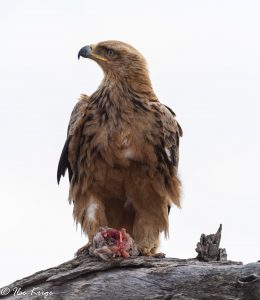
 Giant Kingfisher (Megaceryle maxima)
Giant Kingfisher (Megaceryle maxima)
It was yet another good trip. We consider ourselves lucky to have the Park right on our doorstep.

